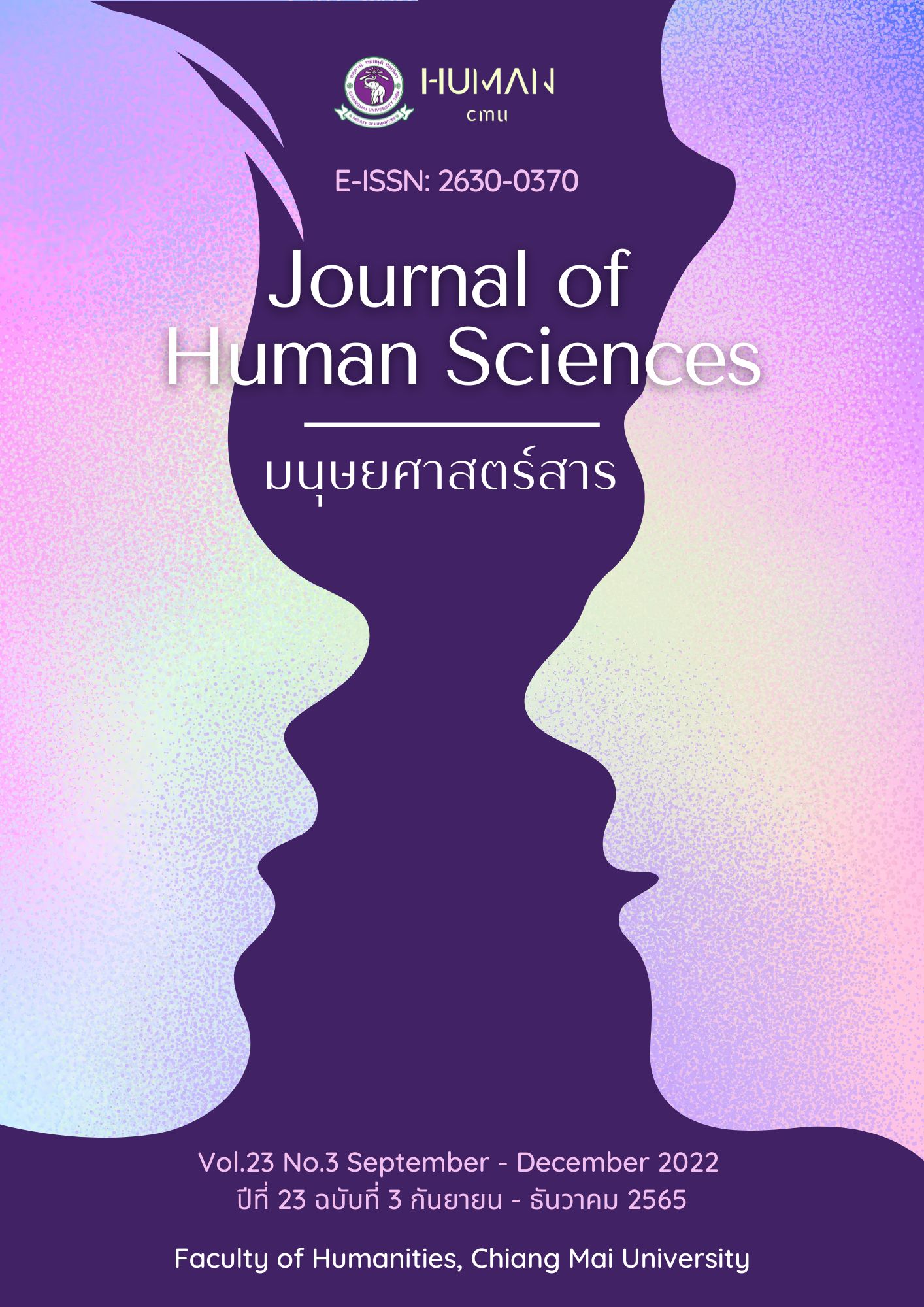ลักษณะการเคลื่อนที่ของ “เวลา” ในภาษาไทยถิ่นเหนือ: ตามแนวภาษาศาสตร์ปริชาน
Main Article Content
บทคัดย่อ
บทความวิจัยเรื่องนี้มีวัตถุประสงค์เพื่อ 1) วิเคราะห์ลักษณะการเคลื่อนที่ของเวลาเมื่อปรากฏร่วมกับคำแสดงการเคลื่อนที่โดยมีทิศทางในแนวดิ่ง คำแสดงการเคลื่อนที่โดยมีทิศทางในแนวระนาบ และคำแสดงการเคลื่อนที่โดยไร้ทิศทาง 2) นำเสนอผังภาพแสดงลักษณะการเคลื่อนที่ของเวลา โดยศึกษาข้อมูลภาษาจากวรรณกรรมประเภทค่าวในช่วงปี พ.ศ. 2325 - 2555 จำนวน 35 เรื่อง ผลการวิจัยพบว่า ลักษณะการเคลื่อนที่ของเวลา มี 3 ลักษณะ ดังนี้
ลักษณะแรก “การเคลื่อนที่โดยมีทิศทางในแนวดิ่ง” เมื่อเวลาปรากฏร่วมกับคำว่า “ขึ้น” ทำให้เข้าใจได้ว่า เวลาสามารถเคลื่อนที่จากล่างไปสู่ด้านบน และเมื่อเวลาปรากฏร่วมกับคำว่า “ลง” ทำให้เข้าใจได้ว่าเวลาเคลื่อนที่จากทิศทางบนลงสู่ล่าง
ลักษณะที่สอง “การเคลื่อนที่โดยมีทิศทางในแนวระนาบ” การเคลื่อนที่นี้สัมพันธ์กับผู้มองเห็นเหตุการณ์การเคลื่อนที่ของเวลา เมื่อเวลาปรากฏร่วมกับคำว่า “เข้า” “ออก” “ไปหน้า” หรือ “ปายหน้า” “ลูน” และ “หลัง”
ลักษณะสุดท้าย “การเคลื่อนที่โดยไร้ทิศทาง” มีลักษณะการเคลื่อนที่ออกไปจากจุดเริ่มต้นแต่ไม่ปรากฏการสิ้นสุดของการเคลื่อนที่ การเคลื่อนที่ยังแสดงเหตุการณ์ที่เกิดขึ้นและผ่านพ้นไป
ลักษณะการเคลื่อนที่ทั้ง 3 ลักษณะแสดงให้เห็นว่า การเคลื่อนผ่านของเวลามีความสัมพันธ์กับมนุษย์ ไม่ว่าการเคลื่อนที่นั้นจะอยูในพื้นที่หรือไม่ได้ระบุพื้นที่ก็ตาม แต่การรับรู้ว่าเวลาเคลื่อนที่ได้นั้นเกี่ยวข้องกับกระบวนการรับรู้ผ่านประสาทสัมผัสของมนุษย์ ผลการศึกษาดังกล่าวนอกจากจะแสดงให้เห็นถึงการเคลื่อนที่ของเวลาดัง 3 ลักษณะที่กล่าวไว้ข้างต้นแล้วยังแสดงถึงความสัมพันธ์ระหว่างระบบความคิด ความรู้ และการรับรู้ผ่านประสาทสัมผัสของผู้มองเห็นการเคลื่อนที่ของเวลาอีกด้วย
Article Details

อนุญาตภายใต้เงื่อนไข Creative Commons Attribution-NonCommercial-NoDerivatives 4.0 International License.
เอกสารอ้างอิง
คนดอย (นามแฝง). (2502). ค่าวจ๊าง 7 หัว 7 หาง. เชียงใหม่: ประเทืองวิทยา.
ค่าวซอช้างโพงนางผมหอม. (2513). เชียงใหม่: ประเทืองวิทยา.
ค่าวซอชิวหาลิ้นคำ. (2511). เชียงใหม่: ประเทืองวิทยา.
ค่าวซอป๋าตะเพียน. (2511). เชียงใหม่: ประเทืองวิทยา.
ค่าวซอสุวรรณเมกฆะหมาขนคำ. (2511). เชียงใหม่: ประเทืองวิทยา.
ค่าวซออ้ายร้อยขอด. (2511). เชียงใหม่: ประเทืองวิทยา.
นายโอ้ต (นามแฝง). (2511). ค่าวซอเรื่องก่ำก๋าดำ. เชียงใหม่: นพบุรีการพิมพ์.
นิคม พรหมาเทพย์. (2534). พระลอคำคร่าว. เชียงใหม่: ม.ป.พ.
นิโลบล ภู่ระย้า. (2556). การศึกษาคำบอกเวลาในภาษาไทยถิ่นอีสานในพื้นที่ภาคอีสานตอนบน. (วิทยานิพนธ์อักษรศาสตรมหาบัณฑิต). กรุงเทพฯ: จุฬาลงกรณ์มหาวิทยาลัย.
ปัญญา (นามแฝง). (2511). ค่าวซอนกกระจาบ. เชียงใหม่: ประเทืองวิทยา.
ปิ่นอนงค์ อำปะละ. (2559). ระบบมโนทัศน์ “เวลา” ของผู้พูดภาษาไทยถิ่นเหนือ (ดุษฎีนิพนธ์ปรัชญาดุษฎีบัณฑิต). กรุงเทพฯ: มหาวิทยาลัยธรรมศาสตร์.
______________. (2563 ก). อุปลักษณ์มโนทัศน์ “เวลาเป็นการเคลื่อนที่” ในภาษาไทยถิ่นเหนือ. (รายงานการวิจัยฉบับที่ 415). เชียงใหม่: มหาวิทยาลัยพายัพ.
______________. (2563 ข). อุปลักษณ์เชิงมโนทัศน์ “เวลาเป็นการเคลื่อนที่ “ลง”ในภาษาไทยถิ่นเหนือ.วารสารมหาวิทยาลัยนราธิวาสราชนครินทร์ (สาขามนุษยศาสตร์และสังคมศาสตร์), 7(1), 45 - 58.
มธุรส คุ้มประสิทธิ์. (2553). การศึกษาเปรียบเทียบวิธีการบอกเวลาในภาษาไทยกรุงเทพฯ กับภาษาซาไกแต๊นแอ๊น ที่อำเภอป่าบอน จังหวัดพัทลุง (วิทยานิพนธ์อักษรศาสตรมหาบัณฑิต). นครปฐม: มหาวิทยาลัยศิลปากร.
มิ่งมิตร ศรีประสิทธิ์. (2548). การศึกษาเวลาในภาษาไทยถิ่นใต้. วารสารภาษาและวรรณคดีไทย, 22(2), 160 -195.
อ้ายไชยเมืองเลน (นามแฝง). (2513). ค่าวซอจั๋นต๊ะฆา. เชียงใหม่: ประเทืองวิทยา.
อุดม รุ่งเรืองศรี. (2528). ค่าวกาวิละ. เชียงใหม่: ศูนย์วัฒนธรรม วิทยาลัยครูเชียงใหม่.
อุดม รุ่งเรืองศรี. (2547). พจนานุกรมล้านนา-ไทยฉบับแม่ฟ้าหลวงตอนที่ 1-2. กรุงเทพฯ: อมรินทร์
พริ้นติ้งกรุ๊ป.
Evans, V. & Green, M. (2006). Cognitive Linguistics: An Introduction. Edinburgh: Edinburgh University Press.
Evans, V. (2015). The Crucible of Language: How Language and Mind Create Meaning. UK: Cambridge University Press.
Johnson, Mark. (1987). The Body in the Mind. Chicago: University of Chicago Press.
Kvalheim, D.R. (2000). Conceptual Metaphor of time in Thai and English. Master of arts in linguistics, Chulalongkorn University, Bangkok.
Lakoff, G & Johnson, M. (1980). Metaphors We Live By. USA. Chicago: The University of
Chicago Press.
Lakoff, George. (1987). Women, fire, and dangerous things: What categories reveal
about the mind. Chicago: University of Chicago Press.
Lee, D. (2002). Cognitive Linguistics: An Introduction. UK: Oxford University Press.
Radden, G. (2003). The Metaphor TIME AS SPACE across Languages. Geburtstag [online], 8 (2-3), 226-239.
Talmy, L. (2000). Toward a Cognitive Semantics. Cambridge: Mass MIT Press.


